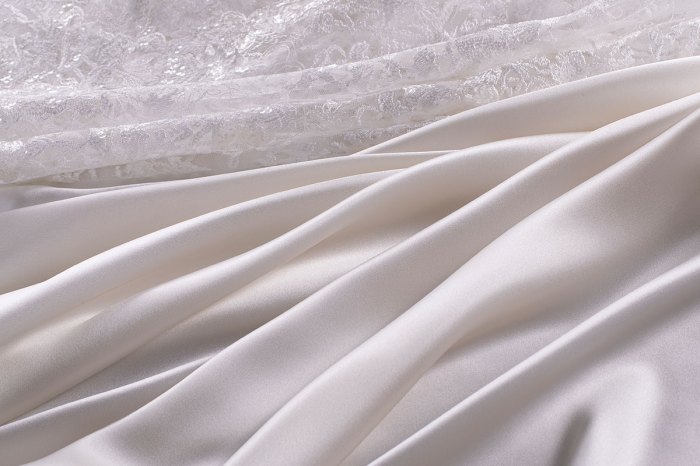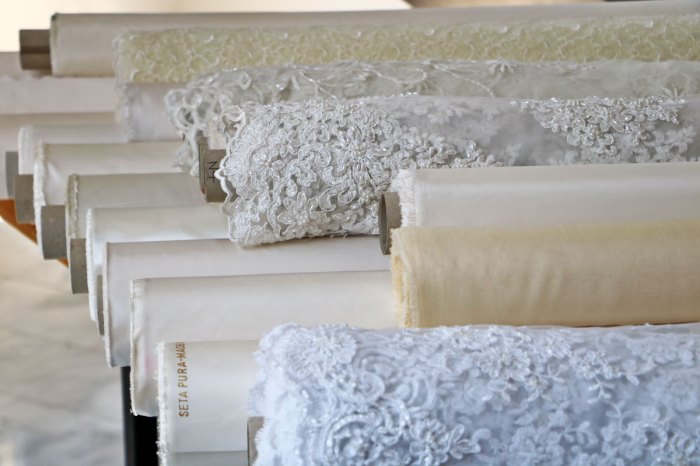Popular Wedding Dress Fabrics
Wedding dress material fabric – Choosing the right fabric for your wedding dress is crucial, as it significantly impacts the overall look, feel, and comfort of the gown. The fabric dictates the drape, silhouette, and even the level of formality. This section explores some of the most popular choices, detailing their properties and suitability for various wedding styles.
Popular Wedding Dress Fabrics: A Detailed Overview
The following table provides a comparison of ten popular wedding dress fabrics, considering texture, common uses, and their advantages and disadvantages.
| Fabric Name | Texture Description | Common Uses | Pros & Cons |
|---|---|---|---|
| Silk | Luxurious, smooth, and lustrous | Classic, elegant gowns; A-line, sheath, and ballgown styles | Pros: Elegant, drapes beautifully; Cons: Expensive, requires delicate care |
| Satin | Smooth, shiny, and sleek | Modern, sleek gowns; mermaid, trumpet, and fit-and-flare styles | Pros: Creates a polished look; Cons: Can be unforgiving on body imperfections |
| Lace | Delicate, intricate patterns; can range from soft to structured | Romantic, vintage gowns; A-line, ballgown, and fit-and-flare styles; often used as an overlay | Pros: Adds texture and detail; Cons: Can be delicate and prone to snagging |
| Tulle | Net-like, sheer, and lightweight | Romantic, whimsical gowns; ballgowns, A-line styles; often used for skirts and overlays | Pros: Creates volume and movement; Cons: Can be itchy for some |
| Chiffon | Lightweight, sheer, and flowing | Bohemian, romantic gowns; A-line, empire waist styles | Pros: Drapes beautifully, creates a soft look; Cons: Can be easily wrinkled |
| Organza | Stiff, crisp, and sheer | Formal, structured gowns; ballgowns, A-line styles; often used for overlays and details | Pros: Holds shape well, creates volume; Cons: Can be unforgiving on body imperfections |
| Crepe | Slightly textured, matte finish | Modern, minimalist gowns; sheath, A-line, and fit-and-flare styles | Pros: Drapes well, hides imperfections; Cons: Can be less luxurious than silk or satin |
| Taffeta | Crisp, smooth, and slightly shiny | Formal, structured gowns; ballgowns, A-line styles | Pros: Holds its shape well, creates volume; Cons: Can be stiff and less comfortable |
| Mikado | Heavy, crisp, and lustrous | Structured gowns; ballgowns, sheath styles | Pros: Holds its shape impeccably; Cons: Can be heavy and less breathable |
| Charmeuse | Smooth, lustrous, and fluid | Sleek, elegant gowns; mermaid, trumpet, and A-line styles | Pros: Luxurious drape, elegant sheen; Cons: Can be delicate and prone to wrinkles |
For example, a silk wedding dress might feature a flowing A-line silhouette that accentuates the fabric’s luxurious drape, while a satin gown might have a sleek mermaid silhouette that highlights its glossy sheen. Lace might be used as an overlay on a tulle gown, creating a romantic and layered effect. The interplay between fabric and design is key to achieving the desired aesthetic.
Silk, with its luxurious drape, flows gracefully, creating a fluid movement. Satin, on the other hand, has a more controlled, sleek movement. Lace, depending on its weight and structure, can have a more delicate, almost ethereal movement, or a more structured, defined movement. Tulle creates dramatic volume and bounce, while chiffon offers a softer, more ethereal flow.
Fabric Properties and Suitability
Understanding the properties of different fabrics is essential for choosing a wedding dress that is both beautiful and comfortable. This section details the properties of several popular fabrics and their suitability for various factors.
Fabric Properties Comparison
This table compares the properties of several key wedding dress fabrics, considering cost, durability, and suitability for different seasons and body types.
| Fabric | Weight | Sheen | Breathability | Cost | Durability | Ease of Cleaning | Suitability for Seasons | Suitability for Body Types |
|---|---|---|---|---|---|---|---|---|
| Silk | Medium to heavy | High | Medium | High | Medium | Low | Spring/Autumn | Most body types |
| Satin | Medium | High | Low | Medium | Medium | Low | Spring/Autumn | Best for slimmer body types |
| Lace | Light to medium | Low to medium | Medium | Medium to high | Medium | Low | Spring/Autumn | Most body types |
| Tulle | Light | Low | High | Low | Low | Medium | All seasons | Most body types |
| Chiffon | Light | Low | High | Low to medium | Low | Medium | Spring/Summer | Most body types |
| Organza | Light | Medium | Medium | Low to medium | Medium | Medium | Spring/Summer | Best for slimmer body types |
| Crepe | Medium | Low | High | Medium | High | Medium | All seasons | Most body types |
| Taffeta | Medium to heavy | Medium | Low | Medium | High | Medium | Spring/Autumn | Best for slimmer body types |
The choice of fabric significantly impacts the silhouette. A heavy fabric like Mikado creates a structured, dramatic silhouette, while a lightweight fabric like chiffon results in a flowing, bohemian look. The fabric also influences the overall aesthetic; a matte crepe creates a modern minimalist look, whereas a shiny satin creates a glamorous, sleek look.
Fabric Care and Maintenance
Proper care and maintenance are crucial for preserving your wedding dress. This section provides a guide to cleaning and caring for different fabrics.
Wedding Dress Fabric Care Guide
Following these guidelines will help to extend the life of your wedding dress.
- Dry Cleaning: Most wedding dresses, especially those made from delicate fabrics like silk or lace, should be professionally dry cleaned.
- Stain Removal: Address stains immediately. For delicate fabrics, blot gently with a clean cloth and seek professional cleaning.
- Storage: Store your dress in a cool, dry place, preferably in a breathable garment bag. Avoid direct sunlight and humidity.
- Acid-Free Tissue Paper: Use acid-free tissue paper to stuff the dress to maintain its shape and prevent wrinkles.
- Professional Preservation: Consider professional preservation services for long-term storage.
Fabric Selection Based on Wedding Style
The fabric choice significantly influences the overall aesthetic of the wedding. This section explores fabric choices based on various wedding styles.
Fabric Choices for Different Wedding Styles
Different fabrics lend themselves to different wedding aesthetics. For example, a bohemian wedding might feature a chiffon or lace gown, while a classic wedding might utilize silk or satin.
- Bohemian: Chiffon, lace, cotton, linen
- Classic: Silk, satin, crepe
- Modern: Crepe, mikado, satin
- Rustic: Lace, tulle, cotton
The visual impact of fabrics varies under different lighting. Shiny fabrics like satin and silk reflect light beautifully, creating a glamorous effect in indoor lighting. Matte fabrics like crepe might appear more understated but can still be stunning in natural light.
Choosing the right wedding dress fabric is crucial; the feel and drape significantly impact the overall look. Consider the season and your personal style when making this decision. For example, if you’re planning a rustic-themed wedding, you might find inspiration for textures in the way others decorate their homes, perhaps even drawing ideas from resources like this guide on dekoration für balken wohnzimmer , which showcases interesting textural elements.
Ultimately, the fabric selection for your wedding dress should reflect your unique personality and the overall aesthetic of your special day.
Sustainable and Ethical Fabrics: Wedding Dress Material Fabric
Increasingly, brides are seeking sustainable and ethical options for their wedding dresses. This section explores eco-friendly and ethically sourced fabrics.
Sustainable Wedding Dress Fabrics, Wedding dress material fabric
Several fabrics offer a more sustainable alternative to traditional choices. Organic cotton, hemp, and recycled materials are gaining popularity.
- Organic Cotton: Grown without harmful pesticides and fertilizers.
- Hemp: Durable, eco-friendly, and requires less water than cotton.
- Recycled Fabrics: Made from pre-consumer or post-consumer waste.
Consider designers who prioritize transparency and ethical labor practices in their production processes. Many designers are now highlighting their commitment to sustainability and ethical sourcing on their websites and in their marketing materials.
Illustrative Descriptions of Fabrics

Source: newtess.com
This section provides detailed descriptions of the textures and appearances of several popular wedding dress fabrics.
Silk Charmeuse
Silk charmeuse is a luxurious fabric with an incredibly smooth, almost buttery texture. Its surface is lustrous and subtly shimmering, reflecting light with a delicate sheen. The drape is fluid and graceful, falling in soft, elegant folds. Touching silk charmeuse is an experience in itself; its coolness against the skin, its subtle give, and its luxurious weight all contribute to a sense of opulence and refined elegance.
Alençon Lace

Source: newtess.com
Alençon lace is renowned for its exquisite intricacy. The patterns are delicate and highly detailed, often featuring floral motifs or geometric designs. The lace itself is lightweight yet strong, with a subtle sheen that enhances its delicate beauty. The overall aesthetic is one of refined elegance and timeless sophistication. The sheerness of the lace, combined with its intricate patterns, creates a sense of both fragility and strength.
Embroidered Tulle
Embroidered tulle presents a beautiful interplay of textures and visuals. The sheer, delicate tulle base provides a soft foundation for the embroidery, which can range from delicate floral patterns to bold geometric designs. The embroidery adds depth and dimension, creating a three-dimensional effect that plays with light and shadow. The overall texture is a blend of softness and subtle structure, with the embroidery adding visual interest and tactile appeal.
Common Queries
How do I determine the right fabric for my body type?
Consider your body shape and desired silhouette. Flowing fabrics like chiffon flatter most figures, while structured fabrics like taffeta create a more defined shape. Consult a bridal stylist for personalized advice.
Can I wash my wedding dress at home?
Generally, professional dry cleaning is recommended, especially for delicate fabrics. Attempting DIY cleaning can risk damaging the dress. Always check the care label for specific instructions.
What is the difference between satin and silk?
Both are luxurious fabrics, but silk is a natural fiber known for its breathability and softness, while satin is a weave that can be made from various fibers, often with a more lustrous finish.
How long does it take to have a wedding dress professionally cleaned?
The timeframe varies depending on the fabric, cleaning method, and the cleaner’s workload. Allow at least several weeks for professional cleaning and preservation.




